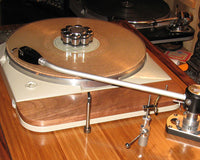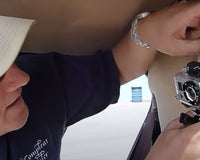Hey, makers and innovators, Ian here. Let's talk about one of the most frustrating problems in 3D printing: you spend hours tuning your settings, leveling your bed, and dialing in your e-steps. You launch a 10-hour print, and when you pull it off the bed, you see it—faint, wavy echoes on every sharp corner.
That, my friends, is "ghosting," (also known as "ringing") and it's the physical evidence that your printer is fighting itself.
It's not a slicer setting, and it's not bad filament. It’s a physics problem. It’s a vibration problem. And today, we're going to solve it at the source.
The Science: What Causes Ghosting?
Ghosting is the visible result of resonance. Your 3D printer creates its own high-frequency vibrations from the rapid, precise movements of its stepper motors. When the print head makes a sudden direction change (like on a sharp corner), it sends a tiny shockwave through the entire printer frame.
If your printer is sitting on a wobbly desk or a resonant (i.e., hollow) shelf, that surface acts like a giant speaker, amplifying those vibrations and reflecting them right back into the printer.
The result? The print nozzle is literally shaking as it tries to lay down a perfectly straight line, leaving behind that tell-tale "ghost" of the vibration.
The Common "Fixes" (And Why They're Incomplete)
The 3D printing community is brilliant and has come up with several DIY fixes. But they all have drawbacks because they don't address the energy of the vibration.
-
The Concrete Paver: This is the most common "heavy" solution. You place your printer on a 20lb concrete paver. This adds mass, which is good—it lowers the natural resonant frequency of the system, making it harder to shake. But it doesn't absorb the vibration. It just tries to resist it. Much of that energy is still reflected right back into the printer's frame.
-
Squash Balls or Foam: This is the "soft" solution. You cut squash balls in half or use foam blocks to "decouple" the printer. This is the right idea, but the wrong material. These materials are springs. They are elastic, meaning they "bounce" the energy. They can often introduce their own low-frequency wobble, which can make print quality even worse.
You don't want to resist vibration or bounce it—you want to absorb it.
The Sorbothane® Solution: An "Energy Sink" for Your Printer
This is where we, as engineers, bring out the right tool for the job. Sorbothane® is not a simple rubber or foam. It is a viscoelastic polymer, which is a technical way of saying it’s a "vibration sink."
When a vibration (from your printer's motors) enters the Sorbothane®, the material deforms at a molecular level and converts that mechanical energy into a tiny, harmless amount of heat. It simply erases the vibration.
-
Rubber bounces energy.
-
Foam muffles energy.
-
Sorbothane® absorbs energy.
By placing Sorbothane® between your printer and the table, you create a "black hole" for vibration. The motors shake, the vibration travels into the Sorbothane®, and it disappears. It never makes it to the table to be amplified, and it's not reflected back into the printer to cause ghosting.
How to Fix Your Printer: From Easy to Pro
Here are two effective ways to solve the problem. The 60-second mod is fantastic for most people, while the "Pro-Mod" is for the dedicated tinkerer.
Project 1: The 60-Second "Decoupler" Mod (The Easy Way)
This is the easiest and most effective all-in-one solution. You decouple the entire printer from the surface it's on.
The Solution: Sorbothane® Hemispheres A set of our Sorbothane® Hemispheres (or "half-spheres") are the perfect tool. Their shape provides the ideal balance of surface contact and damping performance.
What You'll Need:
-
Four Sorbothane® Hemispheres. A 50 Durometer (medium hardness) is a fantastic all-purpose choice for most desktop printers, from a Creality Ender 3 to a Bambu Lab. If you have a very heavy, large-format printer, you might step up to 70 Durometer.
-
(Optional) Adhesive: You can get hemispheres with or without our 3M PSA adhesive backing.
The 60-Second Install:
-
Find the four corners of your printer's frame (or the existing stock feet).
-
Place one Sorbothane® Hemisphere under each corner.
-
That's it. You're done.
You have now "floated" your printer on a high-performance damping system.
Project 2: The "Pro-Mod" (Isolating the Stepper Motors)
For those who love to tinker, you can attack the vibration at its source: the stepper motors. The goal here is to stop the motor's vibration from ever entering the printer's frame.
Making a full Sorbothane® gasket is difficult and can lead to motor "sag" if the material is too soft. A much cleaner and more stable solution is to isolate the screws that mount the motor.
The Solution: Sorbothane® Washers We'll create a "damping sandwich" for each screw, isolating it from the frame.
What You'll Need:
-
8 Sorbothane® Washers (you'll need two per motor screw, so eight total for a NEMA 17 motor).
-
A firm durometer (50D or 70D) is perfect here. It's solid enough to hold the motor rigidly (preventing belt-tension sag) while still absorbing high-frequency vibrations.
The Install:
-
Unscrew one of your stepper motors from the printer frame.
-
For each screw, re-install it using this "damping sandwich" method:
-
Bolt Head->Metal Washer->Sorbothane® Washer->Printer Frame->Sorbothane® Washer->Motor Body
-
-
Tighten the screws down. The Sorbothane® washers will compress slightly, creating a firm, vibration-damped connection. The metal-on-metal contact path is now broken.
This mod isolates the motor's vibration, absorbing it before it can spread through the frame and into your print.
The Payoff: Two Huge Wins
By isolating your printer with Sorbothane® (using either method), you get two incredible results:
-
Visibly Cleaner Prints: With the source of resonance gone, your printer can now move with precision. You will see an immediate, measurable reduction—and in most cases, a complete elimination—of ghosting and ringing.
-
A Drastically Quieter Machine: What was that loud, droning hum? It was your table, vibrating along with your printer. By decoupling it, that amplification is gone. The printer's noise will be reduced to the much quieter, more pleasant sound of the fans and motors themselves. It's a massive quality-of-life upgrade.
Stop "tuning" a physics problem. Just solve it.
What printer are you upgrading? Have you been fighting the "ghosting" war? Let us know in the comments!










